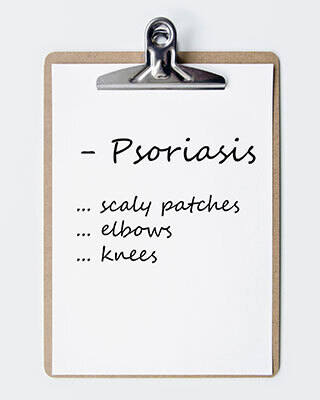Psoriasis Awareness Month

August is Psoriasis Awareness Month: Psoriasis treatments, news and tips
Just like acne, rosacea, and other types of skin flares, psoriasis is an irritating skin condition that is more common than you might think. 7.5 million Americans struggle with psoriasis, which can range from a minor nuisance to an embarrassing and debilitating illness. Psoriasis is more common in light-skinned people and tends to have first onset either during the ages of 20-30 or 50-60, but it can appear at any age. But what causes this burden of a skin condition? There is no one single answer as to how or why individuals develop psoriasis. However, doctors have linked the condition to individuals who have an overactive immune system. If you have a family history of psoriasis, you have a greater risk of developing this skin condition. But family history alone isn’t a guaranteed sentence of psoriasis.
Other conditions that play a role in developing psoriasis
Like many conditions with a genetic component, there also may be an environmental factor. We don’t always completely understand how this works, but some individuals who are more susceptible to a condition like psoriasis may be more likely to get it only with certain external factors combined with the genetic predisposition. Some clues as to what these environmental factors are can be gleaned by looking at the difference between those who develop chronic psoriasis and those who only have psoriasis that comes about only under certain circumstances. For example, some conditions that can cause a psoriasis flare are infections (particularly strep throat), stress, injury to the skin, and several medications.
The Most Common Types of Psoriasis
There are multiple different types of psoriasis that occur, including:
- Plaque psoriasis: This is the “classic” form of psoriasis that most are familiar with. Plaque psoriasis develops as thick red and white raised patches that can cover any part of the skin but most commonly shows up on the elbows, knees, and scalp. This, and other types of psoriasis, can also affect the nails with pits and yellow discoloration as the nail separates from the nail bed.
- Guttate psoriasis: Typically occurs after an individual has experienced strep throat. They are small red dots that appear on the arms, legs, and trunk of the body, and they can clear up in weeks without treatment.
- Pustular psoriasis: This forms as thick red skin with many white liquid filled bumps in the middle. It can often be seen on the palms and soles, but can appear anywhere. This type of psoriasis, when triggered, can sometimes rapidly progress to cover large areas of the body.
- Inverse psoriasis appears where skin to skin contact is made such as the armpits, groin, genitals, and buttocks as raw, red, irritated patches. This type of psoriasis does not have the classic silver scale appearance.
- Erythrodermic psoriasis turns most of the body bright red and it appears as burnt, raw skin. It can be very itchy and painful. This type of psoriasis can sometimes require hospitalization, because it can cause your body to have difficulties regulating body temperature and fluids.
How to Treat Psoriasis
Psoriasis can be treated, but there is no cure. Psoriasis is a long-term, long-lasting skin disease. If you think you may have psoriasis, visit your dermatology provider as soon as possible. Your dermatology provider will examine your skin, scalp, and nails to make the diagnosis.
“With a variety of treatment options ranging from topical creams to light therapy to systemic medications, we have a lot of options for our patients and there are many new ones in the pipeline,” says Dr. Jeremy Fenton of Schweiger Dermatology Group in New York City.
Treating Psoriasis with Oral, Topical and Injectable Medications
For different types of psoriasis, dermatologists will prescribe different types of medication.
Steroid cream is most commonly used for treatment, along with light therapy, occlusion, oral, and injectable medications. “The field of psoriasis treatment has been one of the most exciting and rapidly expanding over the last 10 years, with a significant explosion of options over the last five years,” says Dr. Fenton. “We have a variety of injectable biologic medications that can fully clear the skin in most people. The latest medications target more specific signaling molecules of the immune system called interleukins. We used to only have one or two of these to choose from, but now we have over 10. This means that we can really tailor a patient’s treatment based on the type of psoriasis or other conditions they may have. For those that would like a pill instead of an injection, we also have an oral medication that we have been using for several years called Otezla. This drug blocks an enzyme called phosphodiesterase-4. Although it may not be quite as effective as the injectable medications, it offers an option for those seeking a pill and it does not seem to have as much of a risk of suppressing the immune system. Dermatologists now have a fairly good list of different medications to choose from in order to tailor a patient’s treatment to minimize risk and maximize benefit.”
UV Light Therapy and Psoriasis
Sometimes taking a systemic (oral or injectable) medication can be concerning for people, but if the topical creams aren’t sufficient, UV therapy is a great drug-free option. Natural sunlight can help as well. This may be one of the few instances when you will hear a dermatologist recommend exposure to the sun, but getting a little bit of sun can definitely help psoriasis. “Of course, sun exposure can increase the risk of skin cancer and aging, so it is much safer to get targeted ultraviolet light treatments in a doctor’s office,” says Dr. Fenton. “Dermatologists provide in-office UV exposure with a very specific wavelength of light (narrow-band UVB) that is the most effective on psoriasis. We have been using UVB light therapy to treat psoriasis for many decades, and it has only gotten better. For targeted areas, I like to use the excimer laser.”
Treating Psoriasis at home
Psoriasis patients can benefit from over-the-counter topical treatments such as salicylic acid or tar-based treatments and shampoos (Neutrogena’s T-Gel or T-Sal shampoo are common recommendations). There are a few things patients with psoriasis should be aware of in order to minimize flares. “Maintaining a healthy lifestyle is important – avoiding smoking, minimizing alcohol, keeping a healthy weight, and avoiding stress,” says Dr. Fenton. “Other triggers include trauma to the skin, infections/illness, and certain drugs such as beta blockers and nonsteroidal anti-inflammatory drugs (NSAIDs), especially Naproxen (Aleve).” Psoriasis patients can prevent flares by keeping their skin well moisturized, protected, and by using their topical medications at the first sign of worsening skin condition to prevent it from progressing.
Dr. Jeremy Fenton is a board-certified dermatologist practicing both cosmetic and general dermatology. He serves as the Medical Director for Schweiger Dermatology Group and is a Clinical Instructor at Mt. Sinai Hospital. He sees patients at Schweiger Dermatology Group in Midtown Manhattan.
